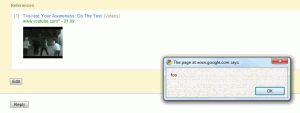02.03
Summary
Google Baraza (www.google.com/baraza/) and Google Ejabat (ejabat.google.com) were vulnerable to a persistent XSS attack. A malicious user could create a post that would trigger JavaScript when an image or link was clicked on.
How did it work?
These Google services allow users to supplement their replies with external links, videos, and other content. When the reply is actually submitted to the server, this extra data is encoded separately from the rest of the message. By manipulating the encoded data in the request to use a javascript URI (ie: javascript:alert(1)) as the link to a video, it was possible to create a post with a link that would execute JavaScript when clicked on.

The XSS vulnerability in Google Baraza. Clicking on the image or the link resulted in JavaScript being executed.
More Information
The vulnerability mentioned here has been confirmed patched by the Google Security Team. I owe them a ton of thanks for organizing this program and giving me a chance to improve my skills.
Interested readers are encouraged to take a look at other vulnerabilities I’ve reported under Google’s Vulnerability Reward Program.

Comments